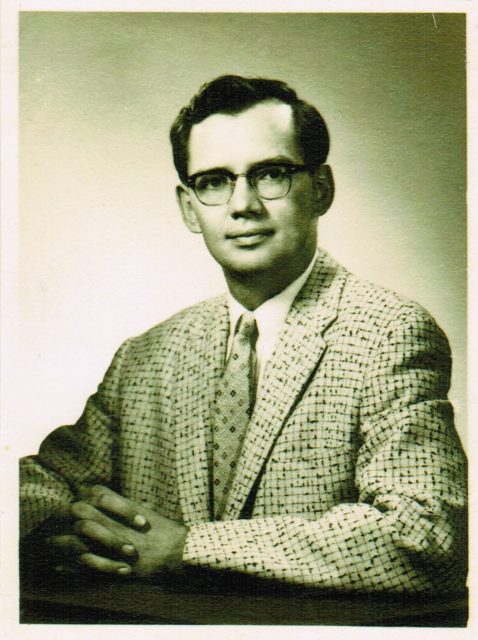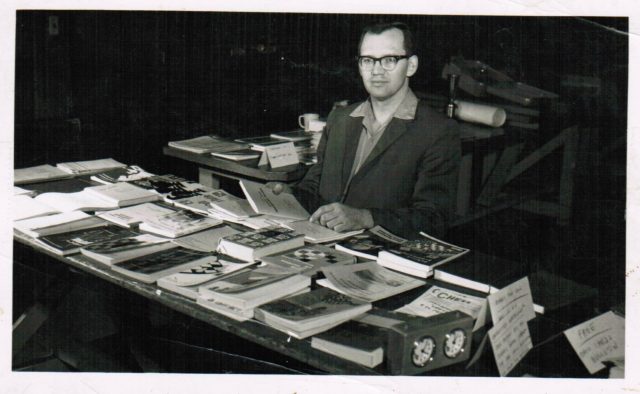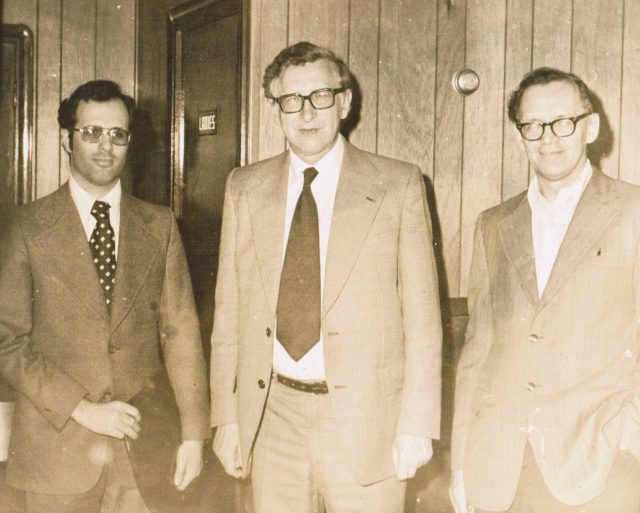 Jim Schroeder circa late 1950s/early 1960s. (Photo: James Schroeder)
Jim Schroeder circa late 1950s/early 1960s. (Photo: James Schroeder)"He was scathingly blunt, had never even crossed paths with the concept of tact, and would do anything for you, up to and including the shirt off his back. He also had a wicked sense of humor." -Douglas Ayers (Jim’s good friend who helped him so much his last few years.)
"James Schroeder was my inspiration for prison chess outreach. He was the father of prison chess." -Steven Frymer (Head of the Prison Committee of the US Chess Federation for several decades.)
"I knew him only thru his spicy writings, 'Confidential Chess Lessons.' He evidently loved chess, brought it to prisoners, studied its history, and did a lot for documenting tournaments. He retired the term 'opinionated.' 'Scathing' does not begin to describe his typical book review. But, occasionally one of his intuitions, like so-and-so was better with knights, hit home. Where else will you find a writer who says on one page, Seirawan is a blithering imbecile, and on the next tells you where to send your money for Seirawan's mag?" -International Master Anthony Saidy
JIM SCHROEDER
(As remembered by David Presser in Cleveland)
I have known Jim since my early teens and first saw him when playing in the Ohio Junior Chess Championship in Columbus where Jim was the tournament director. When Jim moved to Cleveland, we saw each other frequently. One of Jim’s great ideas was a combination chess and table tennis club, which he arranged and which met one evening each week. In 1987 or 1988, he moved to Portland, Oregon, but we remained in touch, and I spoke with Jim for half an hour a few weeks before he passed away. He appeared to be just as sharp as ever.
Jim was married for a time and had a daughter. He served in the Korean War as a radio and Morse code operator. Jim lived on the edge financially for most of his life. He worked in a bookstore for a while in one of the cities of southern Ohio. He tried to survive through chess, but sometimes it wasn’t enough. He told me he sold food at Cleveland Indians’ baseball games occasionally to get by. Jim did come into money once when he inherited $40,000 from his sister, but Jim spent most of the money on donations to prison chess clubs, a charitable endeavor of Jim’s, which lasted several decades. In this way, he helped thousands of prisoners; it noteworthy that the rate of recidivism among prisoners who played chess was very low. In chess, Jim found his calling. He was a strong National Master and had three draws with International Grandmasters to his credit, including a 1958 draw with Pal Benko, who at that time was one of the world’s top 30 players. Jim twice won the Ohio Chess Championship (1950 and 1985). Jim was a successful tournament organizer and chess book dealer. He wrote “Confidential Chess Lessons” for many years and published chess pamphlets, tournament books, bulletins and similar works—a difficult undertaking with only a typewriter. Jim had an encyclopedic knowledge of all aspects of chess and followed World Chess until the last few months of his life. He freely shared his knowledge of chess with many persons and helped some of Cleveland’s top players with their chess development. Although Jim could be irascible, behind that exterior was a very intelligent man with many interests and a large heart. Music was one of his passions! He and I discussed many things by telephone and letter (Jim was old school, no email). Jim’s last gift to me was Grandmaster Yuri Averbach’s autobiography, a treasure that arrived out of the blue last April, a most thoughtful gesture. Jim was my friend. Rest in peace Jim. A typical scene at Cleveland tournaments in the 1960s and 1970s is shown here. Jim Schroeder is pictured selling books, many of which he wrote or produced. (Photo: James Schroeder)
A typical scene at Cleveland tournaments in the 1960s and 1970s is shown here. Jim Schroeder is pictured selling books, many of which he wrote or produced. (Photo: James Schroeder)We now offer a few of Jim’s games. The first is from the 1991 Oregon Open, which he nearly won. Jim drew the following battle against Lubomir Ftacnik and would have shared first place with the Slovak Grandmaster if he had won from a dominating position in the last round. That game, played against many-time Oregon Champion James Bricher, is given in the notes.
[pgn][Event "Oregon Open"]
[Site "Portland"]
[Date "1991.09.01"]
[Round "3"]
[White "Schroeder, James"]
[Black "Ftacnik, Lubomir"]
[Result "1/2-1/2"]
[ECO "B07"]
[PlyCount "81"]
[EventDate "1991.09.01"]
[EventRounds "6"]
[EventCountry "USA"]1. e4 d6 2. d4 Nf6 3. Nc3 g6 4. Bg5 c6 (4... Bg7 5. Qd2 h6 6. Bh4 g5 7. Bg3 Nh5
8. O-O-O Nd7 9. f3 Nxg3 10. hxg3 c5 11. Nge2 Qa5 12. f4 g4 13. e5 cxd4 14. Nxd4
dxe5 15. Nf5 O-O 16. Nxe7+ Kh8 17. f5 $1 (17. Nxc8 Raxc8 18. Qxd7 Rxc3 19. bxc3
Qxc3 20. Qd3 {wins but the text is even stronger.}) 17... Kh7 18. f6 $2 (18.
Qg5 $1 {with the deadly threat of f6.}) 18... Nxf6 19. Bd3+ e4 20. Rxh6+ $4 (
20. Nxe4 {and White is still on top.}) 20... Bxh6 21. Rh1 Nh5 {0-1,
Schroeder-Bricher, Oregon Open (6).}) 5. Qd2 b5 6. Bd3 h6 7. Bh4 e5 8. dxe5
dxe5 9. f4 Nbd7 10. Nf3 b4 11. Ne2 Qe7 12. fxe5 Nxe5 13. Nxe5 (13. Ned4 Bd7 {
and now either} 14. O-O-O {or} (14. O-O {offer White the better chances. What
follows is a solidly played draw.})) 13... Qxe5 14. O-O-O Be7 15. Kb1 Be6 16.
Bg3 Qa5 17. b3 Rd8 18. Qe3 Ng4 19. Qf4 Bf6 20. h3 Qa3 21. Qc1 Qxc1+ 22. Rxc1
Ne5 23. Nf4 Bc8 24. Rcd1 O-O 25. Bf2 Bg5 26. g3 f5 27. Bxa7 Bxf4 28. gxf4 Nxd3
29. cxd3 fxe4 30. dxe4 Rxd1+ 31. Rxd1 Bxh3 32. Rd6 Rxf4 33. Rxc6 Kf7 34. Be3
Rxe4 35. Bxh6 Bf5 36. Kc1 Re1+ 37. Kd2 Rg1 38. Rb6 Rg2+ 39. Ke3 Rxa2 40. Rxb4
Ra7 41. Bg5 1/2-1/2[/pgn]
The following entertaining miniature was played against one of the great gentlemen of chess, National Master James Harkins.
[pgn][Event "Cleveland"]
[Site "?"]
[Date "1968.??.??"]
[Round "?"]
[White "Harkins, James"]
[Black "Schroeder, James"]
[Result "0-1"]
[ECO "C42"]
[EventDate "1968.??.??"]
[PlyCount "36"]1.e4 e5 2.f4 exf4 3.Nf3 g5 4.Bc4
( {Here} 4.h4 {(the main line) and} )
( 4.d4 {are more commonly played.} )
4...g4 5.Ne5
{White declines the chance to enter the romantic Muzio Gambit. One modern example was played by the young Alexey Shirov.}
( 5.O-O gxf3 6.Qxf3 Qf6 7.e5 Qxe5 8.Bxf7+ Kxf7 9.d4 Qxd4+ 10.Be3 Qf6 11.Bxf4 Ke8 12.Nc3 Nc6 13.Nd5 Qg6 14.Rae1+ Be7 15.Bd6 Kd8 16.Qf8+ Bxf8 17.Bxc7# {Shirov-Lapinski, Daugavpils 1990.} )
5...Qh4+ 6.Kf1 Nc6
{Jim makes a spicy dish extra spicy! Anderssen, Steinitz and Chigorin all tested the position after 6...Nh6. Black can also try 6...f3. The text is especially challenging.}
7.Nxf7
{7.Bxf7+!? might be the critical test of 6... Nc6.}
7...Bc5
{Also possible was}
( 7...f3 {meeting} 8.Nxh8 {with}
( 8.d4 b5 9.Bb3 b4 10.Bc4 Na5 )
8...fxg2+ 9.Kxg2 Qh3+ 10.Kf2 Nf6 11.d3 g3+ 12.hxg3 Ng4+ )
8.Qe1 g3 9.Nxh8
( {The alternatives were:} 9.d3 Nf6 10.Nxh8 Ng4 11.Bxf4 Nxh2+ 12.Rxh2 Qxf4+ 13.Ke2 Qe3+ 14.Kd1 Qxe1+ 15.Kxe1 gxh2 )
( {and} 9.d4 Nxd4 10.Nxh8 Nf6 11.Nd2 Ng4 12.Nb3 Nxb3 13.axb3 f3 {In both cases Black is winning.} )
9...Bf2 10.hxg3 Qxh1+ 11.Kxf2 fxg3+ 12.Ke2 Qxg2+ 13.Kd1 d5 14.exd5+ Nge7 15.dxc6
{Or 15.c3 Bg4+ 16.Kc2 Bf5+ 17.Bd3 (17.Kd1 Qh2) 17... Bxd3+ 18.Kxd3 Qxd5+ winning}
( 15.c3 Bg4+ 16.Kc2 Bf5+ 17.Bd3
( 17.Kd1 Qh2 )
17...Bxd3+ 18.Kxd3 Qxd5+ )
15...Bg4+ 16.Be2 Bxe2+ 17.Qxe2 Qh1+ 18.Qe1 g2 0-1[/pgn]
 James Schroeder is pictured standing alongside Vassily Smyslov after the latter gave an exhibition in Cleveland in the mid-1970s. The third person in the photo is unknown. (Photo: James Schroeder)
James Schroeder is pictured standing alongside Vassily Smyslov after the latter gave an exhibition in Cleveland in the mid-1970s. The third person in the photo is unknown. (Photo: James Schroeder)[pgn][Event "Ohio State Championship"] [Site "Columbus"] [Date "1985.09.01"] [Round "5"] [White "Berchenko, Sergey"] [Black "Schroeder, James"] [Result "0-1"] [ECO "B85"] [PlyCount "102"] [EventDate "1985.09.01"] [EventRounds "6"] [EventCountry "USA"]1. e4 c5 2. Nf3 Nc6 3. d4 cxd4 4. Nxd4 Nf6 5. Nc3 d6 6. Bc4 Qb6 7. Nb3 e6 8. Be3 Qc7 9. f4 a6 10. a4 b6 11. O-O Bb7 12. Be2 Be7 13. Bf3 O-O 14. Rf2 Rfd8 15. Rd2 Nd7 16. Qe1 Nc5 17. Nd4 Nxd4 18. Bxd4 e5 19. Be3 exf4 20. Bxf4 Ne6 21. Be3 Bg5 22. Rad1 h6 23. Bg4 Qe7 24. Bxe6 fxe6 25. Bxb6 Bxd2 26. Qxd2 Rd7 27. e5 d5 28. Qd4 Rc8 29. b3 Qf7 30. Rf1 Qg6 31. Rf2 Rf7 32. Rxf7 Qxf7 33. Bc5 Qf5 34. b4 Qxc2 35. h3 Bc6 36. a5 Rc7 37. Nd1 Rf7 38. Ne3 Qe2 39. Kh2 Bb5 40. Ng4 Bd3 41. Nf2 Bc4 42. Ng4 Rf5 43. Ne3 Rg5 44. h4 Rg6 45. Kh3 Bd3 46. g4 Qf3+ 47. Kh2 Be4 48. Qd1 Qf4+ 49. Kh3 Qxe5 50. Bd4 Qf4 51. b5 Bf3 0-1[/pgn]Schroeder was the first researcher to really take advantage of the famous John G. White collection at the Cleveland Public Library, and he used its resources to produce many bulletins and books on forgotten tournaments. Among his best books was Boris Spassky: World’s Greatest Player (1967), the first work in English on Spassky. The series of pamphlets he produced on early World Championship matches, which relied heavily on primary sources, were first rate. Jim could be brutally honest in his reviews, and, for him, it was never personal. He considered his criticism to be professional and constructive, but those on the receiving end did not always see it that way---friend and foe alike! Tony Miles has the record for the shortest book review – Utter crap. – but Jim was not far behind. His review of The Dragon Variation by Anthony Glyn could have ended after the first sentence: “I have one good comment on this slop: the book is well bound.” Although Jim never learned in a major chess center (his entire adult life spent in Ohio, Oregon and Washington), he knew and corresponded with many top players and considered U.S. Chess Hall of Famer Milan Vukcevich a close friend. It was Schroeder that drove the 21-year-old Bobby Fischer from Cleveland to Toledo when the young U.S. champion was on his 1964 transcontinental chess tour. Schroeder was so impressed with the young Fischer that two months later he arranged to have him give an exhibition in Columbus. Those wanting to know more about this remarkable man will want to read Tartajubow’s article, "The Colorful James R. Schroeder" and visit the webpage devoted to the man, Isolanis.com. In closing, we note that Schroeder was recognized by the US Chess Federation before the 2012 U.S. Open held in his adopted hometown of Vancouver. US Chess Executive Director Bill Hall sent Jim a very nice letter, specifically mentioning his contributions to prison chess and gave him a free entry into the U.S. Open, the last tournament he would play. Those who had been most active in pushing for this recognition, Grandmaster Yasser Seirawan and International Master Jeremy Silman, were among Jim’s chief targets in his role as a chess critic, but they recognized and respected his contributions to the game.
Categories
Archives
- April 2024 (43)
- March 2024 (34)
- February 2024 (25)
- January 2024 (26)
- December 2023 (29)
- November 2023 (26)
- October 2023 (38)
- September 2023 (27)
- August 2023 (37)
- July 2023 (47)
- June 2023 (33)
- May 2023 (37)
- April 2023 (45)
- March 2023 (37)
- February 2023 (28)
- January 2023 (31)
- December 2022 (23)
- November 2022 (32)
- October 2022 (31)
- September 2022 (19)
- August 2022 (39)
- July 2022 (32)
- June 2022 (35)
- May 2022 (21)
- April 2022 (31)
- March 2022 (33)
- February 2022 (21)
- January 2022 (27)
- December 2021 (36)
- November 2021 (34)
- October 2021 (25)
- September 2021 (25)
- August 2021 (41)
- July 2021 (36)
- June 2021 (29)
- May 2021 (29)
- April 2021 (31)
- March 2021 (33)
- February 2021 (28)
- January 2021 (29)
- December 2020 (38)
- November 2020 (40)
- October 2020 (41)
- September 2020 (35)
- August 2020 (38)
- July 2020 (36)
- June 2020 (46)
- May 2020 (42)
- April 2020 (37)
- March 2020 (60)
- February 2020 (39)
- January 2020 (45)
- December 2019 (36)
- November 2019 (35)
- October 2019 (42)
- September 2019 (45)
- August 2019 (56)
- July 2019 (44)
- June 2019 (35)
- May 2019 (40)
- April 2019 (48)
- March 2019 (61)
- February 2019 (39)
- January 2019 (30)
- December 2018 (29)
- November 2018 (51)
- October 2018 (45)
- September 2018 (29)
- August 2018 (49)
- July 2018 (35)
- June 2018 (31)
- May 2018 (39)
- April 2018 (31)
- March 2018 (26)
- February 2018 (33)
- January 2018 (30)
- December 2017 (26)
- November 2017 (24)
- October 2017 (30)
- September 2017 (30)
- August 2017 (32)
- July 2017 (27)
- June 2017 (32)
- May 2017 (26)
- April 2017 (37)
- March 2017 (28)
- February 2017 (30)
- January 2017 (27)
- December 2016 (29)
- November 2016 (24)
- October 2016 (32)
- September 2016 (31)
- August 2016 (27)
- July 2016 (24)
- June 2016 (26)
- May 2016 (19)
- April 2016 (30)
- March 2016 (37)
- February 2016 (27)
- January 2016 (33)
- December 2015 (25)
- November 2015 (23)
- October 2015 (16)
- September 2015 (28)
- August 2015 (28)
- July 2015 (6)
- June 2015 (1)
- May 2015 (2)
- April 2015 (1)
- February 2015 (3)
- January 2015 (1)
- December 2014 (1)
- July 2010 (1)
- October 1991 (1)
- August 1989 (1)
- January 1988 (1)
- December 1983 (1)







